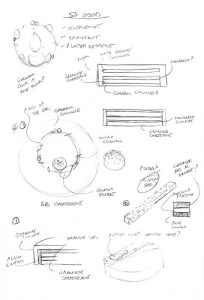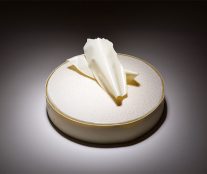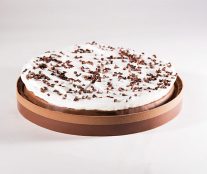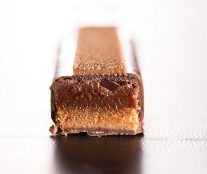Categories Pastry Chef Articles
Scott Green: “I am pushing myself to do more with less”

Scott Green’s career has reached an interesting level of maturity. On the one hand, his four years at the helm of the bakery at the Hotel Langham in Chicago make him enjoy a considerable degree of freedom and, at the same time, a varied palette of records that take him from the plated dessert to the afternoon tea buffets, events, etc. ‘Not two days are the same,’ he tells us happily. In addition to the freedom and respect he has earned among his colleagues and within his team, this chef combines this work with the development of an exciting pastry blog: ‘Devil’s Food Kitchen’. In it, he assures that he wants to return everything he has learned to the sector. From sharing all kinds of recipes to offering clues to their creative processes, Scott Green has found in this project the opportunity to be generous, to share his knowledge, an exercise that is never unidirectional and that ultimately enriches the entire sector.
Another facet that has brought this American chef to the public stage is his love of elite competitions. Lately he has done it as member of a jury, an experience that has allowed him to enjoy equally the emotion that is experienced in these competitions, but from a more placid and analytical point of view, taking into account the virtues and defects which competitors usually go through.
Back in the pages of So good.. we find a Scott Green who does not opt for the use of fashion molds or the use of tools not entirely common in the workshop in the development of a certain idea. His proposals take a look at ingredients and techniques from the near and far east, but always brought to his own sensibility, with a strong European base and with a fondness for the local gastronomic culture. The result is varied, elegant and appetizing, a true declaration of principles that he himself explains to us in the following interview.
In the United States, it is common for pastry chefs to work in large hotels. Is this the most recommended/complete place to work as a pastry chef in America? Would you like to have your own boutique more in the style of French pâtisseries?
Part of what I love about this profession is how many different paths you can choose. The world of pastry is a big one so the best environment to grow your skills is the one that feeds your specific interests. For some cooks and chefs that may mean restaurants, for others it is boutique patisseries. Personally, I’ve always preferred hotels because they give you an opportunity to work on so many different aspects of the profession on a daily basis. No two days are the same in a hotel.
Another step that has most caught our attention lately is the opening of a pastry blog (Devil’s Food Kitchen). Why now?
My blog, Devil’s Food Kitchen, was a project I started so that I could give back to the pastry world, both professional and amateur. I wanted to share all of my secrets, all of my recipes and let people know how I think and create. Many chefs keep their recipes and techniques to themselves, but I’ve never agreed with this. Sharing ideas and inspiring one another will help the industry grow and improve, and that’s good for everyone.
“Sharing ideas and inspiring one another will help the industry grow and improve, and that’s good for everyone.”
 How do you value the frenetic pastry activity that occurs in social networks related to the pastry?
How do you value the frenetic pastry activity that occurs in social networks related to the pastry?
The blog has been an avenue to being very involved in social media, and I have conflicted views about social media and its influence on our industry. On the one side, we have a new and incredible opportunity to instantly share our work with the world, and to find inspiration every moment of the day. It’s amazing to me that I can now see the work of so many talented chefs, chefs that I wouldn’t have known about without social media. It also gives our industry tremendous exposure to the public, free advertising to support us through our food!
On the other side, I am concerned that social media will distort what’s really important with our work. It’s already clear that the most visually appealing cakes, plates and pastries are usually what get the greatest exposure, so it’s tempting as Chefs to put something on a cake or plate simply because it will look good in front of the camera and get us ‘likes’. This is a very dangerous habit that can hurt our industry in the long term. We cannot lose sight of the essence of what we make – food that is experienced in person and should be delicious and enjoyable to eat. I want to see photos of the inside of an entremet become as popular as photos of shiny glaze and elaborate decoration. As I like to say: It’s what’s on the inside that counts.
Tell us about the kind of content you share on your blog and what type of reactions you receive from your followers.
The content on my blog is anything and everything pastry. Most often I am sharing a recipe, and I always give my readers the exact same recipe I use in my kitchen at work. I also like to discuss the science behind recipes and ingredients, which I think is a key to really mastering this craft. It is hard to manipulate a recipe creatively if you don’t know what your ingredients are doing and how they interact with each other. I also like to share my creative process, which is an aspect of our industry that I don’t think has enough exposure. It’s one thing to show someone a special technique, but it’s so much more powerful to show that person how you developed the technique in the first place.
“It’s one thing to show someone a special technique, but it’s so much more powerful to show that person how you developed the technique in the first place”
You have not left behind the competitions arena, your last experience has been as a jury of the AUI Pastry Cup. What do you think the most common sins of the contestants in this type of competitions are? And, on the contrary, what is most stimulating about living it as closely as a member of the jury?
 I really enjoy judging competitions and it provides a new and unique perspective for me. It was exciting to me to see young chefs with fresh perspectives solve the problems of the competition. I felt as though I was competing through their eyes, and it helps to keep my own ideas fresh and remind me of the importance of fundamentals.
I really enjoy judging competitions and it provides a new and unique perspective for me. It was exciting to me to see young chefs with fresh perspectives solve the problems of the competition. I felt as though I was competing through their eyes, and it helps to keep my own ideas fresh and remind me of the importance of fundamentals.
The greatest sin I see as a judge is a failure to organize properly. As a competitor, you can never be too organized, and that preparation will reflect in everything else you do. It’s very clear to a judge which competitors are well practiced and prepared and which competitors are not, and usually their product will match in quality.
What would you highlight about the techniques of the products that you present to us?
I have made a very conscious effort to use simple tools, simple techniques, and basic molds in creating my work for this edition. Elaborate molds and machines have become a trend in our industry and they produce incredible and eye-catching work, but I am pushing myself to do more with less. The foundation of this craft has been working with our hands, and that is something I don’t want to see lost to technology.
“Elaborate molds and machines have become a trend in our industry and they produce incredible and eye-catching work, but I am pushing myself to do more with less”
What is the creative concept and the flavors that you highlight?
Each of my products has a creative life all of its own. I begin with a kernel of an idea and don’t know exactly where it may take me. One flavor is experimented with another until the right combination is formed. More flavors are added and then begin to evolve with technique. In the end I have a product that may be exactly what I originally envisioned or something completely different. It’s a process I never get tired of.
Although there’s no singular theme to all of my work, I have been drawn to Middle Eastern and Asian flavors and ingredients. What I have developed isn’t an attempt to interpret literal or traditional dishes. Instead this collection has been a fusion of those flavors with my experience and interests.
You will also find these three recipes in so good #19





